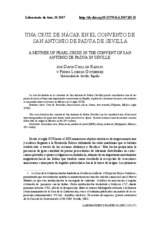Mostrar el registro sencillo del ítem
Una cruz de nácar en el convento de San Antonio de Padua de Sevilla
| dc.contributor.author | Chillón Raposo, David | |
| dc.contributor.author | Luengo Gutiérrez, Pedro | |
| dc.date.accessioned | 2023-02-21T10:05:04Z | |
| dc.date.available | 2023-02-21T10:05:04Z | |
| dc.date.issued | 2007 | |
| dc.identifier.uri | http://hdl.handle.net/10396/24757 | |
| dc.description.abstract | La cruz localizada en el convento de San Antonio de Padua (Sevilla) puede considerarse una de las piezas de nácar y ébano más importantes conservadas en España. A partir de cuestiones técnicas y decorativas se ha podido datar su factura en México en el siglo XVIII. | es_ES |
| dc.description.abstract | The cross found in the convent of San Antonio de Padua (Seville) can be considered one of the most interesting mother-of-pearl and ebony work preserved in Spain. Several technical and decorative reasons allow date its origin in Mexico in the 18th century. | es_ES |
| dc.format.mimetype | application/pdf | es_ES |
| dc.language.iso | spa | es_ES |
| dc.publisher | Editorial Universidad de Sevilla | es_ES |
| dc.rights | https://creativecommons.org/licenses/by-nc-sa/4.0/ | es_ES |
| dc.source | Laboratorio de Arte 20, 253-271 (2007) | es_ES |
| dc.subject | Cruz de Jerusalén | es_ES |
| dc.subject | Franciscanos | es_ES |
| dc.subject | Nácar | es_ES |
| dc.subject | Ébano | es_ES |
| dc.subject | Arte oriental | es_ES |
| dc.subject | Filipinas | es_ES |
| dc.subject | México | es_ES |
| dc.subject | Siglo XVIII | es_ES |
| dc.subject | Jerusalem cross | es_ES |
| dc.subject | Franciscans | es_ES |
| dc.subject | Mother-of-pearl (MOP) | es_ES |
| dc.subject | Ebony | es_ES |
| dc.subject | Orient art | es_ES |
| dc.subject | Philippines | es_ES |
| dc.subject | 18th century | es_ES |
| dc.title | Una cruz de nácar en el convento de San Antonio de Padua de Sevilla | es_ES |
| dc.title.alternative | A mother of pearl cross in the convent of San Antonio de Padua in Seville | es_ES |
| dc.type | info:eu-repo/semantics/article | es_ES |
| dc.relation.publisherversion | https://revistascientificas.us.es/index.php/LAB-ARTE/issue/archive | es_ES |
| dc.rights.accessRights | info:eu-repo/semantics/openAccess | es_ES |

